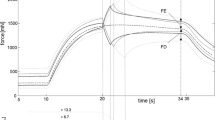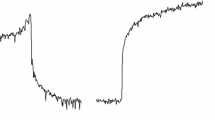Abstract
The passive and active length–tension (L–T p and L–T a) relationships in airway, vascular, and detrusor smooth muscles can adapt with length changes and/or multiple contractions. The present objectives were to (1) determine whether short-term adaptation at one muscle length shifts the entire L–T a curve in detrusor smooth muscle (DSM), (2) compare adaptation at shorter versus longer lengths, and (3) determine the effect of adaptation on the T p/T a ratio. Results showed that multiple KCl-induced contractions on the descending limb of the original L–T a curve adapted DSM strips to that length and shifted the L–T a curve rightward. Peak T a at the new length was not different from the original peak T a, and the L–T p curve shifted rightward with the L–T a curve. Multiple contractions on the ascending limb increased both T a and T p. In contrast, multiple contractions on the descending limb increased T a but decreased T p. The T p/T a ratio on the original descending limb adapted from 0.540 ± 0.084 to 0.223 ± 0.033 (mean ± SE, n = 7), such that it was not different from the ratio of 0.208 ± 0.033 at the original peak T a length, suggesting a role of length adaptation may be to maintain a desirable T p/T a ratio as the bladder fills and voids over a broad DSM length range.






Similar content being viewed by others
Abbreviations
- 0-Ca:
-
Nominally Ca2+-free solution consisting of PSS without CaCl2
- APS:
-
Adjustable passive stiffness
- ASM:
-
Airway smooth muscle
- DSM:
-
Detrusor smooth muscle
- KPSS:
-
PSS modified to include 110 mM KCl substituted isosmotically for NaCl
- L–T:
-
Length–tension
- L–Ta:
-
Length–active tension
- L o :
-
Optimal length for active tension generation
- L–Tp:
-
Length–passive tension
- PSS:
-
Physiological salt solution
- T a :
-
Active tension
- T o :
-
Peak, optimal T a
- T p :
-
Passive tension
- T t :
-
Total tension
- VSM:
-
Vascular smooth muscle
References
Almasri, A. M., P. H. Ratz, H. Bhatia, A. P. Klausner, and J. E. Speich. Rhythmic contraction generates adjustable passive stiffness in rabbit detrusor. J. Appl. Physiol. 108(3):544–553, 2010.
Bai, T. R., J. H. Bates, V. Brusasco, B. Camoretti-Mercado, P. Chitano, L. H. Deng, M. Dowell, B. Fabry, L. E. Ford, J. J. Fredberg, W. T. Gerthoffer, S. H. Gilbert, S. J. Gunst, C. M. Hai, A. J. Halayko, S. J. Hirst, A. L. James, L. J. Janssen, K. A. Jones, G. G. King, O. J. Lakser, R. K. Lambert, A. M. Lauzon, K. R. Lutchen, G. N. Maksym, R. A. Meiss, S. M. Mijailovich, H. W. Mitchell, R. W. Mitchell, W. Mitzner, T. M. Murphy, P. D. Pare, R. R. Schellenberg, C. Y. Seow, G. C. Sieck, P. G. Smith, A. V. Smolensky, J. Solway, N. L. Stephens, A. G. Stewart, D. D. Tang, and L. Wang. On the terminology for describing the length-force relationship and its changes in airway smooth muscle. J. Appl. Physiol. 97(6):2029–2034, 2004.
Bosse, Y., A. Sobieszek, P. D. Pare, and C. Y. Seow. Length adaptation of airway smooth muscle. Proc. Am. Thorac. Soc. 5(1):62–67, 2008.
Brocklehurst, R. J. Studies on the physiology of plain muscle: The effect of alteration of initial length on the tension produced on contraction. J. Physiol. 61(2):275–281, 1926.
de Groat, W. C. A neurological basis for the overactive bladder. Urology 50:36–52, 1997.
Dulin, N. O., D. J. Fernandes, M. Dowell, S. Bellam, J. McConville, O. Lakser, R. Mitchell, B. Camoretti-Mercado, P. Kogut, and J. Solway. What evidence implicates airway smooth muscle in the cause of BHR? Clin. Rev. Allergy Immunol. 24(1):73–84, 2003.
Ford, L. E. Plasticity in airway smooth muscle: an update. Can. J. Physiol. Pharmacol. 83(10):841–850, 2005.
Ford, L. E., C. Y. Seow, and V. R. Pratusevich. Plasticity in smooth muscle, a hypothesis. Can. J. Physiol. Pharmacol. 72(11):1320–1324, 1994.
Gordon, A. M., A. F. Huxley, and F. J. Julian. The variation in isometric tension with sarcomere length in vertebrate muscle fibres. J. Physiol. 184(1):170–192, 1966.
Gordon, A. R., and M. J. Siegman. Mechanical properties of smooth muscle. I. Length-tension and force-velocity relations. Am. J. Physiol. 221(5):1243–1249, 1971.
Gregersen, H., J. L. Emery, and A. D. McCulloch. History-dependent mechanical behavior of guinea-pig small intestine. Ann. Biomed. Eng. 26(5):850–858, 1998.
Gunst, S. J., R. A. Meiss, M. F. Wu, and M. Rowe. Mechanisms for the mechanical plasticity of tracheal smooth muscle. Am. J. Physiol. 268(5 Pt 1):C1267–1276, 1995.
Gunst, S. J., and W. Zhang. Actin cytoskeletal dynamics in smooth muscle: A new paradigm for the regulation of smooth muscle contraction. Am. J. Physiol. Cell Physiol. 295(3):C576–587, 2008.
Herlihy, J. T., and R. A. Murphy. Length-tension relationship of smooth muscle of the hog carotid artery. Circ. Res. 33(3):257–283, 1973.
Jezior, J. R., J. D. Brady, D. I. Rosenstein, K. A. McCammon, A. S. Miner, and P. H. Ratz. Dependency of detrusor contractions on calcium sensitization and calcium entry through LOE-908-sensitive channels. Br. J. Pharmacol. 134:78–87, 2001.
Longhurst, P. A., J. S. Kang, A. J. Wein, and R. M. Levin. Comparative length-tension relationship of urinary bladder strips from hamsters, rats, guinea-pigs, rabbits and cats. Comp. Biochem. Physiol. A 96(1):221–225, 1990.
Murphy, R. A., and C. M. Rembold. The latch-bridge hypothesis of smooth muscle contraction. Can. J. Physiol. Pharmacol. 83(10):857–864, 2005.
Poley, R. N., C. R. Dosier, J. E. Speich, A. S. Miner, and P. H. Ratz. Stimulated calcium entry and constitutive RhoA kinase activity cause stretch-induced detrusor contraction. Eur. J. Pharmacol. 599:137–145, 2008.
Pratusevich, V. R., C. Y. Seow, and L. E. Ford. Plasticity in canine airway smooth muscle. J. Gen. Physiol. 105(1):73–94, 1995.
Seow, C. Y. Response of arterial smooth muscle to length perturbation. J. Appl. Physiol. 89(5):2065–2072, 2000.
Seow, C. Y., V. R. Pratusevich, and L. E. Ford. Series-to-parallel transition in the filament lattice of airway smooth muscle. J. Appl. Physiol. 89(3):869–876, 2000.
Silveira, P. S., J. P. Butler, and J. J. Fredberg. Length adaptation of airway smooth muscle: A stochastic model of cytoskeletal dynamics. J. Appl. Physiol. 99(6):2087–2098, 2005.
Speden, R. N. The effect of initial strip length on the noradrenaline-induced contraction of arterial strips. J. Physiol. 154(1):15–25, 1960.
Speich, J. E., A. M. Almasri, H. Bhatia, A. P. Klausner, and P. H. Ratz. Adaptation of the length-active tension relationship in rabbit detrusor. Am. J. Physiol. Renal Physiol. 297(4):F1119–1128, 2009.
Speich, J. E., L. Borgsmiller, C. Call, R. Mohr, and P. H. Ratz. ROK-induced cross-link formation stiffens passive muscle: Reversible strain-induced stress softening in rabbit detrusor. Am. J. Physiol. Cell Physiol. 289(1):C12–21, 2005.
Speich, J. E., C. Dosier, L. Borgsmiller, K. Quintero, H. P. Koo, and P. H. Ratz. Adjustable passive length-tension curve in rabbit detrusor smooth muscle. J. Appl. Physiol. 102(5):1746–1755, 2007.
Speich, J. E., K. Quintero, C. Dosier, L. Borgsmiller, H. P. Koo, and P. H. Ratz. A mechanical model for adjustable passive stiffness in rabbit detrusor. J. Appl. Physiol. 101(4):1189–1198, 2006.
Syyong, H., C. Cheung, D. Solomon, C. Y. Seow, and K. H. Kuo. Adaptive response of pulmonary arterial smooth muscle to length change. J. Appl. Physiol. 104(4):1014–1020, 2008.
Uvelius, B. Isometric and isotonic length-tension relations and variations in longitudinal smooth muscle from rabbit urinary bladder. Acta Physiol. Scand. 97(1):1–12, 1976.
Uvelius, B. Length-tension relations of in vitro urinary bladder smooth muscle strips. J. Pharmacol. Toxicol. Methods 45(2):87–90, 2001.
Wang, L., P. D. Pare, and C. Y. Seow. Plasticity in skeletal, cardiac, and smooth muscle: Selected contribution: Effect of chronic passive length change on airway smooth muscle length-tension relationship. J. Appl. Physiol. 90(2):734–740, 2001.
Acknowledgments
We gratefully acknowledge the expert technical assistance of Amy S. Miner and the support and guidance of Dr. Harry P. Koo. This study was supported by a grant from the Edwin Beer Research Program in Urology and Urology Related Fields from the New York Academy of Medicine (to J.E.S.). Some bladders used for these studies were from rabbits used for vascular smooth muscles studies supported by National Heart, Lung and Blood Institute Grant No. R01-HL61320 (to P.H.R.).
Author information
Authors and Affiliations
Corresponding author
Additional information
Associate Editor Kent Leach oversaw the review of this article.
Rights and permissions
About this article
Cite this article
Almasri, A.M., Ratz, P.H. & Speich, J.E. Length Adaptation of the Passive-to-Active Tension Ratio in Rabbit Detrusor. Ann Biomed Eng 38, 2594–2605 (2010). https://doi.org/10.1007/s10439-010-0021-7
Received:
Accepted:
Published:
Issue Date:
DOI: https://doi.org/10.1007/s10439-010-0021-7




